Rear Disc Brake Pads Replacement 15 Series W/O NYS
Caution: Refer to Brake Dust Caution in the Preface section.
Removal Procedure
- Inspect the fluid level in the brake master cylinder reservoir.
- If the brake fluid level is midway between the maximum-full point and the minimum allowable level, no brake fluid needs to be removed from the reservoir before proceeding.
- If the brake fluid level is higher than midway between the maximum-full point and the minimum allowable level, remove brake fluid to the midway point before proceeding.
- Raise and support the vehicle. Refer to Lifting and Jacking the Vehicle in General Information.
- Remove the tire and wheel assembly. Refer to in Tire and Wheel Removal and Installation Tires and Wheels.
- Remove the caliper from the mounting bracket and support the caliper with heavy mechanic's wire or equivalent. DO NOT disconnect the hydraulic brake flexible hose from the caliper. Refer to Front Brake Caliper Replacement .
- Inspect the caliper assembly. Refer to Brake Caliper Inspection .
- Remove the brake pads from the brake caliper bracket.
- Remove the brake pad retainers from the brake caliper bracket.
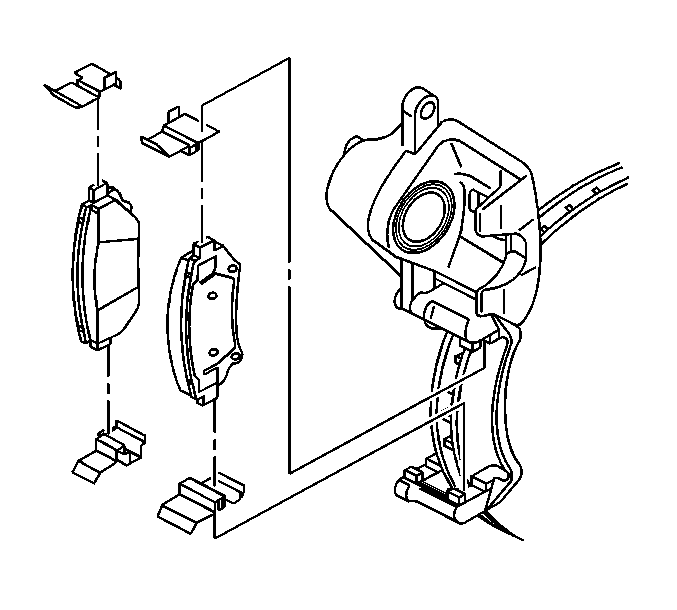
Notice: Support the brake caliper with heavy mechanic wire, or equivalent, whenever it is separated from its mount and the hydraulic flexible brake hose is still connected. Failure to support the caliper in this manner will cause the flexible brake hose to bear the weight of the caliper, which may cause damage to the brake hose and in turn may cause a brake fluid leak.
Installation Procedure
- Using a C-clamp (1), bottom the piston into the caliper bore. Use an old brake pad (2) or wooden block placed across the face of the piston. Do not damage the piston or the caliper boot.
- Ensure that the piston boot is below the level of the piston face.
- Install the brake pad retainers to the caliper bracket.
- Install the brake pads over the brake pad retainers and onto the caliper bracket.
- Install the caliper to the caliper mounting bracket.
- Install 2 new caliper guide pin bolts.
- Install the tire and wheel assembly. Refer to Tire and Wheel Removal and Installation in Tires and Wheels.
- Lower the vehicle.
- With the engine OFF, gradually apply the brake pedal to approximately 2/3 of its travel distance.
- Slowly release the brake pedal.
- Wait 15 seconds, then repeat steps 9-10 until a firm pedal is obtained. This will properly seat the brake caliper pistons and brake pads.
- Fill the master cylinder reservoir to the proper level with clean brake fluid. Refer to Master Cylinder Reservoir Filling in Hydraulic Brakes.
- Burnish the pads and the rotors. Refer to Brake Pad and Rotor Burnishing .
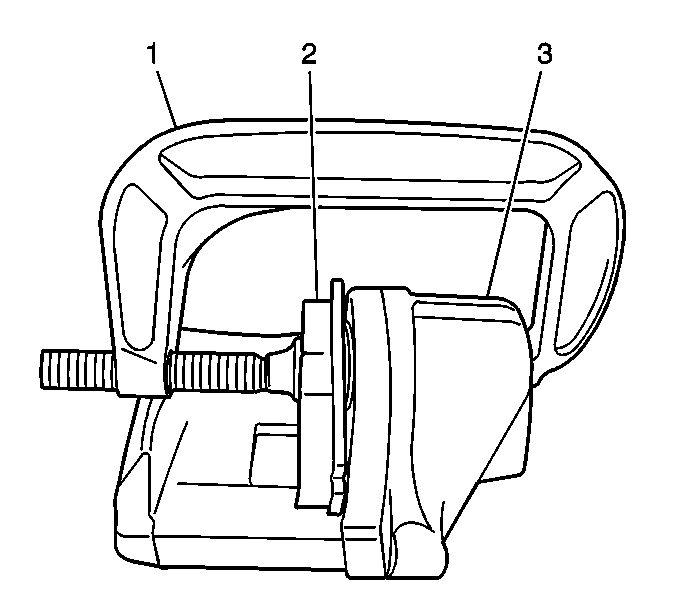
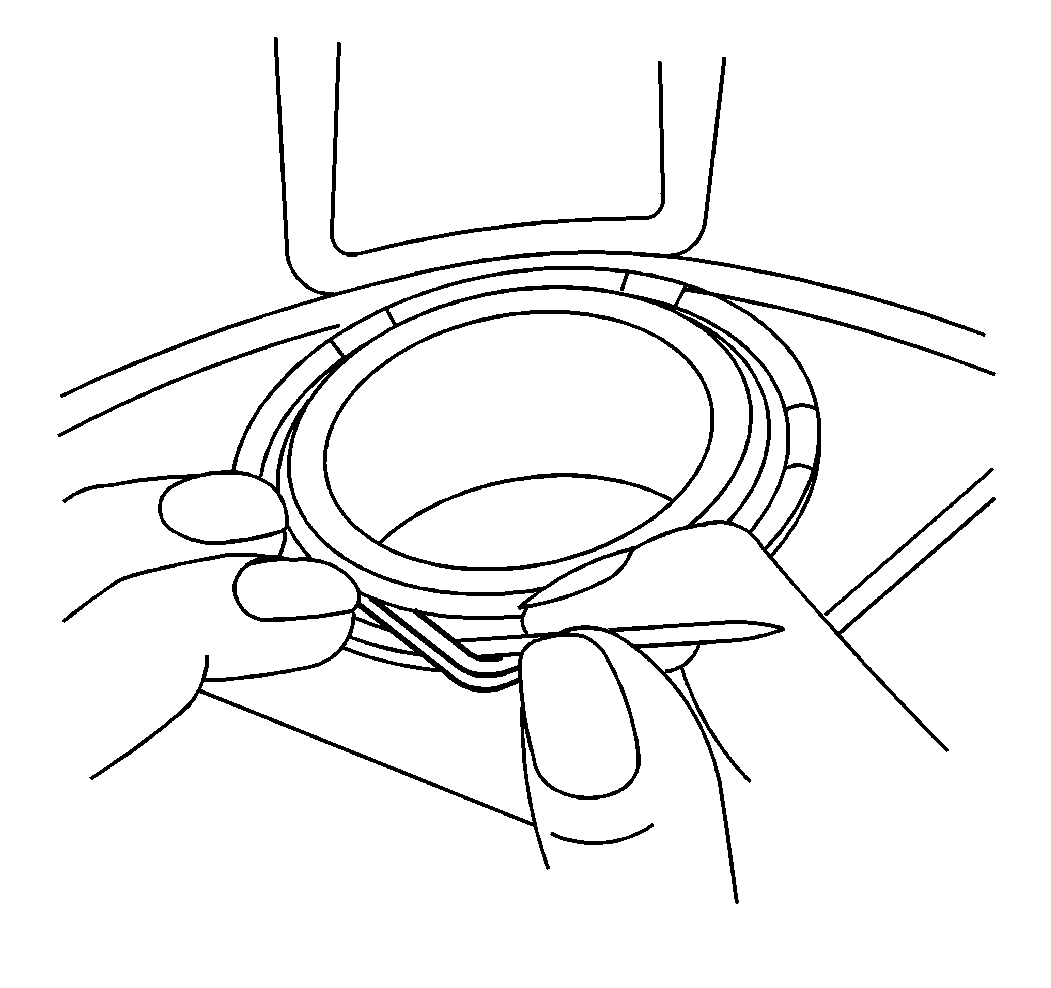
Important: Use a small flat-bladed tool and lift the inner edge caliper boot next to the piston to release any trapped air.

Important: Ensure that the wear sensor is positioned at the leading edge, upward, of the inner pad during forward wheel rotation.
Notice: Use the correct fastener in the correct location. Replacement fasteners must be the correct part number for that application. Fasteners requiring replacement or fasteners requiring the use of thread locking compound or sealant are identified in the service procedure. Do not use paints, lubricants, or corrosion inhibitors on fasteners or fastener joint surfaces unless specified. These coatings affect fastener torque and joint clamping force and may damage the fastener. Use the correct tightening sequence and specifications when installing fasteners in order to avoid damage to parts and systems.
Tighten
Tighten the 2 caliper guide pin bolts to 42 N·m (31 lb ft).
Rear Disc Brake Pads Replacement All except 1500 Series W/O NYS
Caution: Refer to Brake Dust Caution in the Preface section.
Removal Procedure
- Inspect the fluid level in the brake master cylinder reservoir.
- If the brake fluid level is midway between the maximum-full point and the minimum allowable level, no brake fluid needs to be removed from the reservoir before proceeding.
- If the brake fluid level is higher than midway between the maximum-full point and the minimum allowable level, remove brake fluid to the midway point before proceeding.
- Raise and support the vehicle. Refer to Lifting and Jacking the Vehicle in General Information.
- Remove the tire and wheel assembly. Refer to Tire and Wheel Removal and Installation in Tires and Wheels.
- Inspect the brake caliper operation. Refer to Brake Caliper Inspection .
- Remove the brake caliper from the brake caliper mounting bracket and support the brake caliper with heavy mechanic's wire or equivalent. DO NOT disconnect the hydraulic brake hose from the brake caliper. Refer to Rear Brake Caliper Replacement .
- Inspect the brake caliper assembly. Refer to Brake Caliper Inspection .
- Remove the disc brake pads from the brake caliper mounting bracket.
- Remove and discard the anti-rattle clips from the brake caliper mounting bracket.
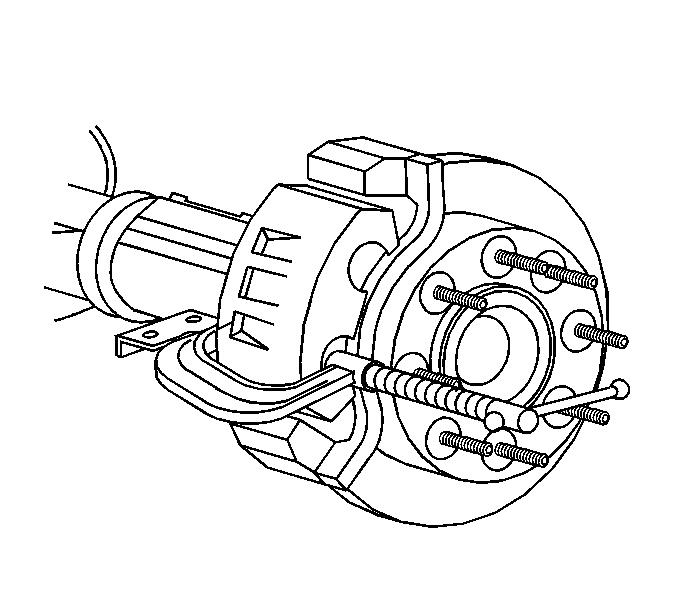
Notice: Support the brake caliper with heavy mechanic wire, or equivalent, whenever it is separated from its mount and the hydraulic flexible brake hose is still connected. Failure to support the caliper in this manner will cause the flexible brake hose to bear the weight of the caliper, which may cause damage to the brake hose and in turn may cause a brake fluid leak.
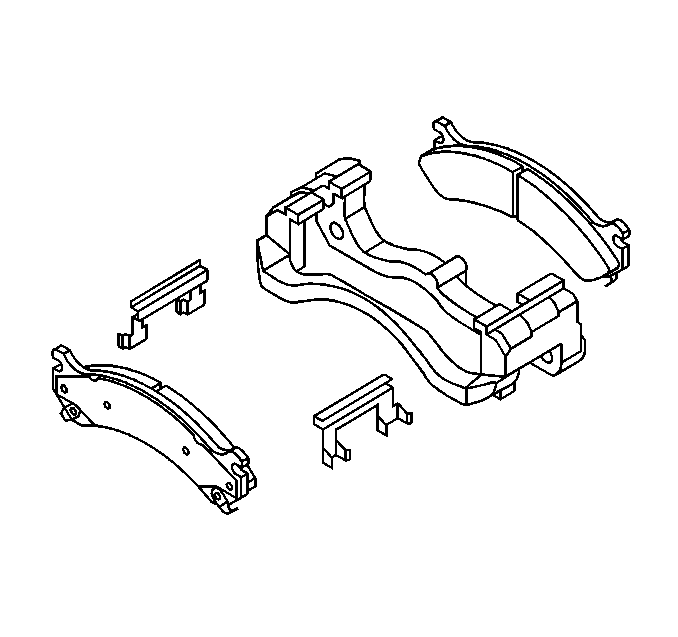
Installation Procedure
- Install the anti-rattle clips to the brake caliper mounting bracket.
- Install the disc brake pads to the brake caliper mounting bracket.
- Install the brake caliper to the brake caliper mounting bracket. Refer to Rear Brake Caliper Replacement .
- Install the tire and wheel assembly. Refer to Tire and Wheel Removal and Installation in Tires and Wheels.
- Remove the safety stands.
- Lower the vehicle.
- With the engine OFF, gradually apply the brake pedal to approximately 2/3 of it's travel distance.
- Slowly release the brake pedal.
- Wait 15 seconds, then repeat steps 7-8 until a firm pedal is obtained. This will properly seat the brake caliper pistons and brake pads.
- Fill the master cylinder reservoir to the proper level with clean brake fluid. Refer to Master Cylinder Reservoir Filling in Hydraulic Brakes.
- Burnish the brakes pads and rotors as necessary. Refer to Brake Pad and Rotor Burnishing .

